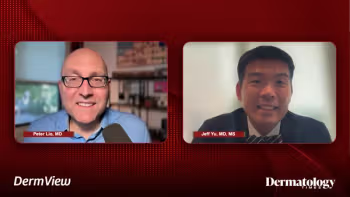
- Dermatology Times, May 2025 (Vol. 46. No. 05)
- Volume 46
- Issue 05
Supporting Patients With Rare Genetic Skin Diseases and the Foundations Dedicated to Them
Key Takeaways
- Patient-focused foundations like FIRST and PC Project are essential for advancing research in rare genetic skin diseases.
- Smaller grants from foundations can significantly impact early-career dermatology researchers, facilitating career progression and scientific discoveries.
In his May letter, Christopher Bunick, MD, PhD, reflects on his journey as a physician-scientist and advocates for supporting foundations dedicated to rare skin diseases.
My journey as a dermatology physician-scientist is deeply rooted in rare genetic skin diseases—and shaped by the generosity of patient-focused foundations such as the
When I started my postdoctoral research in 2011 in the laboratory of Thomas Steitz, PhD, a Nobel Prize laureate in chemistry in 2009, my research focus was on the structure and function of keratins. In particular, I studied keratin 1 (K1) and keratin 10 (K10), which are associated with certain ichthyosis subtypes (eg, epidermolytic ichthyosis1). I was in need of funding to hire my first laboratory member in 2016 when my fortunes changed: I applied for and received a research grant from FIRST. FIRST awarded me a 2-year grant that enabled me to hire my first postgraduate associate. The lab’s ensuing work on K1 and K10 ultimately led to the discovery of a novel assembly mechanism utilized by intermediate filament proteins to form mature cytoskeleton filaments.2 This discovery became the central focus of my first National Institutes of Health R01 grant. Therefore, an important lesson for early dermatology investigators is that smaller awards from foundations can make a huge impact on one’s dermatology career trajectory.
FIRST facilitated my transition from an early-career physician-scientist, initially funded by the Dermatology Foundation, to a principal investigator funded by FIRST.3 I encourage medical students, residents, and early career faculty to consider dermatology foundations that are supporting different areas of skin disease, as these foundations often have research grants to assist young clinicians and scientists in their quest for discovery. Moreover, these foundations have annual meetings that integrate the patient experience with cutting-edge science so that we as the clinicians and investigators hear what it is like to live with rare, genetic skin diseases and cooperate to push research forward.4
A second foundation crucial to my career development was the PC Project, which is dedicated to patients with PC. I became involved with the PC Project in 2015 when my Yale dermatology mentor, Leonard Milstone, MD, encouraged me to attend the International PC Consortium (IPCC) ahead of the Society for Investigative Dermatology (SID) Annual Meeting that year. I found the research invigorating, and it was a room full of people who spoke my language of intermediate filaments, skin barrier, protein science, and elevating patient care.5 Each year I continue to attend the IPCC meeting before the SID meeting for its serious dedication to patient care and high-quality science.
What follows are 4 key ways the PC Project makes a difference to dermatology clinicians and our patients: (1) Its diagnostic registry provides individual and community support to patients with PC and other rare and painful palmoplantar keratodermas (PPKs), including genetic testing to find the exact pathogenic variation causing their symptoms. These answers can be life-changing for patients who have often spent decades visiting multiple doctors and not understanding why they have had painful, permanent calluses on their feet since childhood. (2) Due to its diagnostic registry, the PC Project collects clinical and genetic data on not only the 5 types of PC but also on the approximately 10 other rare, genetic skin disorders associated with painful PPK (using a 49-gene panel). (3) To generate interest and to advance PC-specific research, the PC Project facilitates and funds grants to young investigators and to established investigators who have demonstrated a commitment to PC research. (4) PC Project is a collaborative organization that unites bright physicians/scientists dedicated to improving the lives of these mostly forgotten patients. PC Project invites interested professionals to join the IPCC and lend their hearts and their expertise to this cause.
The clinicians and investigators of both FIRST and PC Project are top-notch people, with tremendous gratitude and generosity toward our specialty and our patients. I have a genuine desire for all my colleagues in dermatology to experience these foundations as well as others dedicated to enhancing patient care and innovation of new therapies and funding the early careers of our future leaders. If you are a reader and have not joined FIRST or PC Project, I strongly encourage you to and to be an active part of their community. It will be greatly rewarding for you personally, and it will positively impact the lives of patients with rare, genetic skin diseases and their families.
Why is community support needed more than ever? Patients with ichthyosis and PC are still feeling the sting of recent clinical trial failures. After promising phase 2 clinical trial data,6-9 topical isotretinoin 0.05% ointment did not distinguish itself significantly from placebo in its phase 3 trial (ASCEND; NCT05295732). Similarly, a phase 3 clinical trial (VAPAUS; NCT05643872) of 3.9% rapamycin anhydrous gel (Qtorin; Palvella Therapeutics, Inc) for PC did not meet trial end points.10 Both of these medications were expected to be first-in-disease treatments and to bring much-needed relief and options to patients with ichthyosis and PC. As an investigator in both these trials (also illustrating how one’s career can progress from basic science research to clinical trials), I was personally devastated for the rare skin disease community (patients and families) who had high hopes for real therapeutic advancement. I do believe, however, that we can mobilize and unite as a specialty to provide more commitment to rare, genetic skin disease research, and it starts by supporting life-changing and worthy foundations like FIRST and PC Project. Please join me in doing so. We can make a difference!
For research follow-up, I will be attending and presenting at the 2025
Christopher Bunick, MD, PhD, is an associate professor of dermatology and a physician-scientist at Yale School of Medicine in New Haven, Connecticut.
Disclosures: Bunick is on the medical and scientific advisory boards for FIRST and PC Project.
References
- Epidermolytic ichthyosis: a patient’s perspective. Foundation for Ichthyosis and Related Skin Types. Accessed April 14, 2025.
https://www.firstskinfoundation.org/types-of-ichthyosis/epidermolytic-ichthyosis - Eldirany SA, Ho M, Hinbest AJ, Lomakin IB, Bunick CG. Human keratin 1/10-1B tetramer structures reveal a knob-pocket mechanism in intermediate filament assembly. EMBO J. 2019;38(11):e100741. doi:10.15252/embj.2018100741
- Ho M, Nguyen HN, Van Hoang M, et al. Altered skin microbiome, inflammation, and JAK/STAT signaling in Southeast Asian ichthyosis patients. Hum Genomics. 2024;18(1):38. doi:10.1186/s40246-024-00603-x
- Lilly E, Bunick CG. Congenital ichthyosis: a practical clinical guide on current treatments and future perspectives. Clin Cosmet Investig Dermatol. 2023;16:2473-2479. doi:10.2147/CCID.S388608
- Wu TT, Eldirany SA, Bunick CG, Teng JMC. Genotype-structurotype-phenotype correlations in patients with pachyonychia congenita. J Invest Dermatol. 2021;141(12):2876-2884.e4. doi:10.1016/j.jid.2021.03.035
- Teng JMC, Bunick CG, Guenthner S, et al. The CONTROL study: a randomized, double-blind vehicle-controlled phase 2b study of novel topical isotretinoin formulation demonstrates improvement in recessive X-linked and autosomal recessive lamellar congenital ichthyosis. J Am Acad Dermatol. 2022;87(6):1455-1458. doi:10.1016/j.jaad.2022.07.028
- Marathe K, Teng JMC, Guenthner S, et al. Topical isotretinoin (TMB-001) treatment for 12 weeks did not result in clinically relevant laboratory abnormalities in participants with congenital ichthyosis in the phase 2b CONTROL study. Dermatol Ther (Heidelb). 2023;13(6):1255-1264. doi:10.1007/s13555-023-00923-1
- Murrell DF, Teng JMC, Guenthner S, et al. Phase IIb randomized CONTROL study demonstrates a novel topical isotretinoin formulation, TMB-001, is safe and effective in participants with either recessive X-linked or autosomal recessive lamellar congenital ichthyosis. Clin Exp Dermatol. 2023;48(6):623-630. doi:10.1093/ced/llad033
- Bunick CG, Teng JMC, Guenthner S, et al. Characteristics and outcomes for participants with congenital ichthyosis who responded to treatment with the topical isotretinoin formulation TMB-001: results from the phase IIb CONTROL study. Clin Exp Dermatol. 2023;48(7):765-769. doi:10.1093/ced/llad105
- Palvella Therapeutics reports topline results from pivotal phase 3 VAPAUS study of Qtorin 3.9% rapamycin anhydrous gel (Qtorin rapamycin) for the treatment of pachyonychia congenita. Palvella Therapeutics Inc. News release. July 20, 2023. Accessed April 14, 2025.
https://palvellatx.com/2023/07/20/palvella-therapeutics-reports-topline-results-from-pivotal-phase-3-vapaus-study-of-qtorin-rapamycin-pachyonychia-congenita/
Articles in this issue
Newsletter
Like what you’re reading? Subscribe to Dermatology Times for weekly updates on therapies, innovations, and real-world practice tips.


















